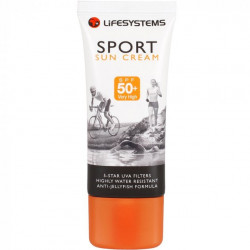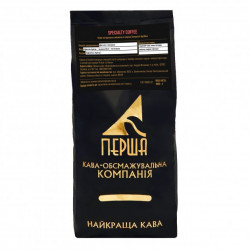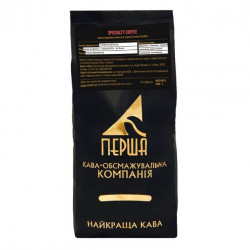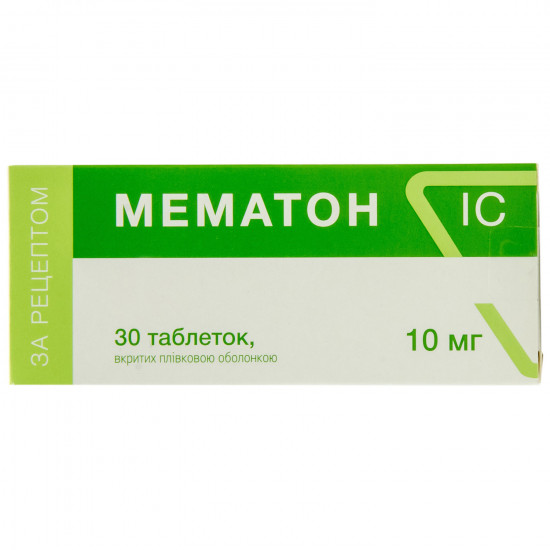
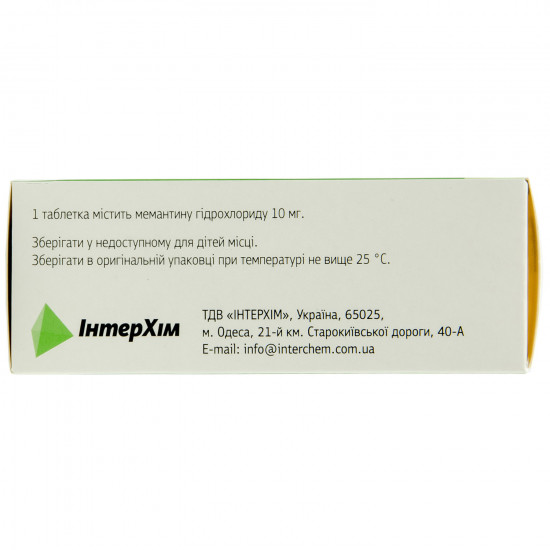
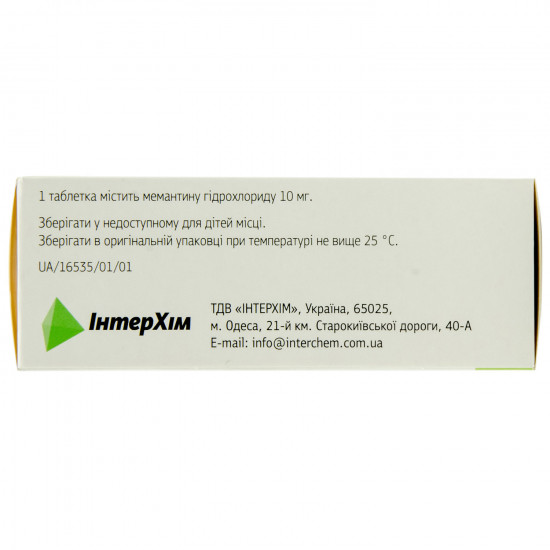



- Stock: In Stock
- Model: 184309
0% Customers recommend this product
-
5 Awesome0%
-
4 Great0%
-
3 Average0%
-
2 Bad0%
-
1 Poor0%
Reviews Over Mematon _s tab. of p/o of 10 mg No. 30
- (0)
Total Reviews (0)
click here write review to add review for this product.
Report this review.
Description
Pharmacological properties
Pharmacodynamics. in manifestations and progressing of neurodegenerative dementia an important role is played by disturbance of glutamatergichesky neurotransmission, especially with participation n-methyl-d-aspartate (nmda) - receptors.
Miemangting representspotentsialzavisimy, average affinity the noncompetitive antagonist of NMDA receptors. Miemangting modulates effects patholologically of the increased glutamate level which can lead to dysfunction of neurons.
Clinical performance and safety. By results of a research at patients with Alzheimer's disease from moderate severity to severe forms in 6 months of monotherapy memantiny the positive effect of treatment in comparison with placebo was observed (on scales of CIBIC-plus, ADCS-ADLsev, SIB).
byAt patients with Alzheimer's disease easy and moderate severity on the 24th week of a research noted significant positive effect of treatment memantiny in comparison with the patients receiving placebo (on scales of ADAS-cog, CIBIC-plus). However it was reported about a prospective research of efficiency of monotherapy memantiny with participation of patients with Alzheimer's disease easy and moderate severity which primary analysis of data established achievements of statistical significance in primary final point on the 24th week of treatment.
placebo Meta-analysis - controlled researches with participation of patients with Alzheimer's disease from moderate severity to severe forms (including data of researches using monotherapy memantiny and researches with participation of patients at whom applied maintenance doses of inhibitors of acetylcholinesterase) showed tosignificant positive effect of treatment memantiny in relation to cognitive, functional and general domains. Results showed that at patients with disturbances at the same time in three domains memantin showed significant positive effect according to prevention of aggravation of symptoms; among participants there are researches at which aggravation of symptoms was noted, the patients receiving placebo was twice more, than patients to whom applied memantin (21% against 11%).
Pharmacokinetics. Absorption. The bioavailability of a memantin is about 100%, time of achievement of the C max in blood plasma (Tmax) — from 3 to 8 h. There are no signs of influence of meal on absorption.
Distribution. The daily dose of 20 mg causes stable concentration of a memantin in blood plasma within 70–150 ng/ml (0.5-1 µmol) with considerable individual variations. At use of daily doses from 5 to 30 mg the ratio of concentration of a memantin in cerebrospinal liquid and concentration in blood serum averages 0.52. The volume of distribution is about 10 l/kg. About 45% of a memantin contact proteins of blood plasma.
Metabolism. In a human body about 80% of a memantin circulate in the form of not changed substance. The main metabolites — N-3.5-dimetilgludantan, isomerous mix of a 4- and 6-hydroksimemantin and 1-nitrozo-3.5-dimetiladamantana — have no NMDA antagonistic properties. Participation of P450 cytochrome in metabolism of in vitro is not revealed.
Removal. In a research at oral introduction 14 C-memantina on average of 84% of a dose eliminirovano a course of 20 days, more than 99% of a dose are removed by kidneys.
Miemangting is monoexponentsialno brought bywith T ½ 60–100 h. Volunteers with normal function of kidneys have the general clearance (Cl tot ) is 170 ml/min. / 1.73 m 2 , a part of the general renal clearance is reached due to canalicular secretion.
Renal stage of pharmacokinetics of a memantin includes also canalicular reabsorption which, perhaps, mediated by the cationic transport system. Speed of renal elimination of a memantin in the conditions of alkali reaction of urine can decrease by 7–9 times (see. Special INSTRUCTIONS). Alkalization of urine can result from significant changes in a food allowance, for example replacement of a diet rich with meat dishes by vegetarian, or owing to intensive reception of antiacid gastric means.
Linearity. According to researches with participation of volunteers the pharmacokinetics of a memantin has linear character in the range of doses of 10-40 mg.
Pharmakodinamicheskaya / pharmacokinetic communication. At use of a memantin in a dose of 20 mg/days the level of a memantin in cerebrospinal liquid corresponds to the size k i (an inhibition constant) a memantina that makes 0.5 µmol in a frontal cerebral cortex of the person.
Indication
Alzheimer's disease from light severity to severe forms.
Use
Treatment should be begun and carried out byunder observation of the doctor. therapy can be begun only on condition of presence of the trustee who will regularly control administration of medicament by the patient.
should take the Pill in 1 times a day at the same time daily. A pill can be taken together with food or irrespective of meal.
Adult. Titration of a dose. The maximum daily dose makes 20 mg. For the purpose of reduction of risk of emergence of negative reactions of a maintenance dose it is necessary to reach by gradual increase in a dose on 5 mg/week during the first 3 weeks according to the following scheme:
1st week (day the 1-7th): to accept 5 mg (½ tablets a dosage of 10 mg) 1 time a day within 7 days;
2nd week (day the 8-14th): to accept 10 mg (1 tablet a dosage of 10 mg) 1 time a day within 7 days;
3rd week (day the 15-21st): to accept on 15 mg (1½ tablets a dosage of 10 mg) 1 time a day within 7 days;
since 4th week: to accept 20 mg (2 tablets a dosage 10 mg or 1 tablet a dosage of 20 mg) 1 time a day.
Maintenance dose. The recommended maintenance dose makes 20 mg/days
treatment Duration individually the doctor having experience of diagnostics and treatment of Alzheimer's disease defines. It is regularly necessary to estimate shipping and the applied doses of a memantin, it is better within 3 months after an initiation of treatment. Further the clinical effect of a memantin and reaction of the patient to treatment should be estimated regularly according to the existing clinical recommendations. The supporting treatment can be continued while the therapeutic effect remains favorable, and shipping of a memantin the patient — good. It is necessary to consider the possibility of the termination of treatment memantiny if signs of therapeutic effect disappear or the shipping of treatment by the patient worsens.
Patients of advanced age. On the basis of results of clinical trials the recommended dose for patients aged from 65 years makes 20 mg/days (2 tablets a dosage 10 mg or 1 tablet a dosage of 20 mg of 1 times a day) as it is stated above.
Patients with a renal failure. With a renal failure of light severity (clearance of creatinine of 50-80 ml/min.) of dose adjustment of medicament it is not required to patients. For patients with a renal failure of moderate severity (clearance of creatinine of 30-49 ml/min.) the daily dose has to make 10 mg. The dose can be raised to 20 mg/days according to the standard scheme of titration if the patient has a good tolerance of medicament within 7 days of treatment. For patients with a renal failure of heavy degree (clearance of creatinine of 5-29 ml/min.) the daily dose has to make 10 mg.
Patients with an abnormal liver function. Easy or moderate severity (class A and B on Chayld's scale — I Drink) dose adjustment of medicament is not required to patients with an abnormal liver function. Use of a memantin is not recommended to patients with a heavy abnormal liver function due to the lack of data on use of a memantin in this group of patients.
Contraindication
Hypersensitivity to a memantin or any of auxiliary components of drug.
Period of pregnancy and feeding by a breast.
Children's age (up to 18 years).
Side effectsduring clinical placebos - controlled researches of a memantin with participation of patients with dementia easy and moderate severity the general frequency of cases of side reactions at patients at whom applied memantin did not differ in
from that at the patients receiving placebo; side reactions had severity from easy to average. side reactions Given below which were observed during clinical trials and during the post-marketing period on frequency are distributed by
as follows: very often (≥1/10), it is frequent (≥1/100 and 1/10), infrequently (≥1/1000 and 1/100), is rare (≥1/10,000 and 1/1000), is very rare (1/10,000), frequency is unknown (it is impossible to estimate on the available data).
from nervous system: often — dizziness, balance disturbance; infrequently — disturbance of gait; very seldom — convulsive attacks.
Mental disturbances: often — drowsiness; seldom — confusion of consciousness, a hallucination *; frequency is unknown — psychotic reactions **.
from a cardiovascular system: often — AG; seldom — venous thrombosis / tromboembolizm, heart failure.
from a respiratory system: often — an asthma.
from digestive system: often — a constipation; seldom — vomiting; frequency is unknown — pancreatitis **.
from a gepatobiliarny system: often — increase in indicators of function of a liver; frequency is unknown — hepatitis.
from the immune system: often — reactions of hypersensitivity.
Infection and invasion: infrequently — fungus diseases.
General disturbances: often — a headache; infrequently — increased fatigue.
* Hallucinations mainly notedat patients with a severe form of Alzheimer's disease.
** Separate messages during the post-marketing period.
Alzheimer's disease is connected bywith a depression, suicide thoughts and suicide. Such cases are registered during the post-marketing period at the patients receiving memantin.
Special instructions
Miemangting should be applied with care at patients with epilepsy, episodes of spasms in the anamnesis or risk factors of developing epilepsy.
Should avoid simultaneous use of a memantin with such NMDA antagonists as amantadin, ketamine or dextromethorphan. These connections influence the same system of receptors, as memantin therefore the side effects (which are generally connected with central nervous system) can be more frequent or more expressed (see INTERACTIONS).
Some factors causing increase rn urine (see. Pharmacological PROPERTIES), can cause need of careful observation of the patient. The specified factors include significant changes in a food allowance, for example replacement of a diet rich with meat dishes by vegetarian, or intensive reception of antiacid gastric means. Besides, rn urine can raise because of a condition of renal tubular acidosis (NTA) or heavy infections of the urinary tract caused by Proteus bacteria.
patients who recently had a myocardial infarction with dekompensirovanny stagnant heart failure (the III-IV degrees on classification of NYHA) or uncontrollable AG were eliminated byIn the majority of clinical trials participants. Thereof there are only limited relevant data that causes need of careful observation of patients with such diseases.
Use during pregnancy and feeding by a breast. Pregnancy period. Data on influence of a memantin at its use during pregnancy are absent or are limited. Pilot studies on animals indicate a possibility of delay of pre-natal growth at influence of the concentration of a memantin identical or slightly above that are applied at the person. The potential risk for the person is unknown. Miemangting it is not necessary to apply during pregnancy, except for cases when it is obviously necessary.
feeding Period breast. It is unknown whether there is excretion of a memantin in breast milk, but, in view of lipophilicity of substance, it probably after all occurs. Drug should not be used during feeding by a breast.
Fertility. Researches on reproductive toxicity did not reveal influence on fertility of animals women's and male.
Children. Not to use medicament at children (aged up to 18 years) because of insufficiency of data on safety and efficiency of use of a memantin in this group of patients.
Ability to influence speed of response at control of vehicles or work with other mechanisms. Alzheimer's disease from moderate severity to severe forms usually leads to decrease in an opportunity to drive the car and disturbance of ability to work with mechanisms. Besides, memantin has insignificant or moderate influence on the speed of response of the person therefore ambulatory patients should be warned about need of respect for extra care at control of motor transport or work with the equipment.
Interaction
Mechanism of action assumes possible strengthening of effects of a levodopa, dofaminergichesky agonists and anticholinergics at simultaneous use of such nmda-antagonists as memantin. easing of effects of barbiturates and neuroleptics is possible. co-administration of a memantin and antispasmodics, a dantrolen or Baclofenum can modify their effects, can cause need of correction of doses.
Should avoid simultaneous use of a memantin and an amantadin because of risk of pharmakotoksichesky psychosis. Both connections are chemically connected NMDA antagonists. The same can treat ketamine and dextromethorphan (see. Special INSTRUCTIONS). Also it was reported about possible risk of the combined use of a memantin and Phenytoinum.
Other medicines, such as Cimetidinum, ranitidine, procaineamide, quinidine, quinine and nicotine which are transported by the same cationic transport system of kidneys and amantadin, perhaps, are also capable to interact with memantiny, causing potential risk of increase in levels in blood plasma.
At the combined use of a memantin with a hydrochlorothiazide or any combination containing a hydrochlorothiazide the decrease in level of a hydrochlorothiazide in blood serum is possible.
. Though the causal relationship is not established, careful monitoring of a prothrombin time or the Ministry of Taxes and Tax Collection at the patients who are at the same time accepting oral anticoagulants is necessary.
toduring the pharmacokinetic researches among healthy volunteers of essential effects of interaction of a memantin with Glyburidum/metformin, donepezil or Galantaminum it is not established.
Miemangting of in vitro is not CYP inhibitor 1A2, 2A6, 2C9, 2D6, 2E1, 3A, flavinsoderzhashchy monooxygenase, an epoksidgidrolaza or a sulfation.
Overdose
Data on overdose of a memantin are limited to results of clinical trials and post-marketing experience.
Symptoms. Rather considerable overdoses (200 mg and 105 mg within 3 days respectively) were connected with symptoms of increased fatigue, weakness and/or diarrhea or had an asymptomatic course. In cases of the overdose caused by reception of a dose of 140 mg or an unspecified dose at patients disturbances from central nervous system were noted (confusion of consciousness, slackness, drowsiness, dizziness, excitement, aggression, hallucinations, disturbances of gait) and/or disturbances from a GIT (vomiting and diarrhea).
toIt was reported that after reception of 2000 mg of a memantin inside at the patient the coma within 10 days, later — a diplopia and agitation developed. After symptomatic treatment and a plasma exchange the patient recovered without permanent complications. In other case of overdose as a result of reception of 400 mg of a memantin at the patient disturbances from central nervous system were observed, such as concern, psychosis, visual hallucinations, the increased convulsive readiness, drowsiness, a stupor and a loss of consciousness. After treatment the patient also recovered.
Treatment. Symptomatic treatment, specific antidote does not exist. It is necessary to apply standard clinical procedures to removal of active ingredient from an organism, for example gastric lavage, intake of activated carbon (interruption of potential gastrohepatic recirculation), urine acidulation methods, an artificial diuresis.
in case of symptoms of excessive general stimulation of central nervous system symptomatic therapeutic actions should be applied with care.
Storage conditions
In original packing at a temperature not above 25 °C.
Specifications
| Characteristics | |
| Active ingredients | Miemangting |
| Amount of active ingredient | 10 mg |
| Applicant | Interkhim |
| Code of automatic telephone exchange | N06DX01 Miemangting |
| Interaction with food | It doesn't matter |
| Light sensitivity | Not sensitive |
| Market status | The branded generic |
| Origin | Chemical |
| Prescription status | According to the prescription |
| Primary packing | blister |
| Producer | INTERKHIM ODO |
| Quantity in packing | 30 tablets (3 blisters on 10 pieces) |
| Release form | tablets for internal use |
| Route of administration | Oral |
| Sign | Domestic |
| Storage temperature | from 5 °C to 25 °C |
| Trade name | Mematon |













![Wireless Samsung Wireless Charger Stand charger [LO] with TA 12W Black Wireless Samsung Wireless Charger Stand charger [LO] with TA 12W Black](https://www.martnets.com/image/cache/catalog/goods/my/4632/33_1500-250x250w.png)
![Wireless Samsung Wireless Charger Stand charger [LO] with TA 12W Black Wireless Samsung Wireless Charger Stand charger [LO] with TA 12W Black](https://www.martnets.com/image/cache//catalog/goods/my/gallery/4632/33/898408_middle-250x250w.png)
















